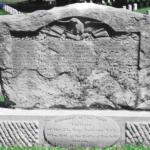Home | 32nd Indiana Monument
The Oldest Civil War Monument Saved
By Michael A. Peake
In a brief though bloody Civil War battle at Rowlett’s Station, the Green River town of Munfordville, Kentucky, bore witness to the inevitable clash of arms between the Union and Confederate forces on December 17, 1861. During that savage, close quarter combat, thirteen German immigrants of the 1st German, 32nd Regiment Indiana Volunteer Infantry paid the ultimate price of devotion to their adopted homeland. Soon after their burials at Munfordville, Private August Bloedner, noted for meritorious conduct during the battle, hand carved a beautiful monument to his comrades that was laid among the graves in January 1862. After the war, the remains of the dead, along with the monument, were removed in the summer of 1867 to Louisville’s Cave Hill Cemetery as part of the Federal mandate to recover all Union dead to National Cemeteries. At that time, the memorial was mounted upright on a commemorative base stone that ultimately contributed to the deterioration of what has become the oldest surviving Civil War monument in the Nation.
By Michael A. Peake
In a brief though bloody Civil War battle at Rowlett’s Station, the Green River town of Munfordville, Kentucky, bore witness to the inevitable clash of arms between the Union and Confederate forces on December 17, 1861. During that savage, close quarter combat, thirteen German immigrants of the 1st German, 32nd Regiment Indiana Volunteer Infantry paid the ultimate price of devotion to their adopted homeland. Soon after their burials at Munfordville, Private August Bloedner, noted for meritorious conduct during the battle, hand carved a beautiful monument to his comrades that was laid among the graves in January 1862. After the war, the remains of the dead, along with the monument, were removed in the summer of 1867 to Louisville’s Cave Hill Cemetery as part of the Federal mandate to recover all Union dead to National Cemeteries. At that time, the memorial was mounted upright on a commemorative base stone that ultimately contributed to the deterioration of what has become the oldest surviving Civil War monument in the Nation.
By the time a serious preservation effort to save the stone began in early 2000, Bloedner’s monument had lost much of the German Fraktur-style inscription providing an account of the fight and the names of the dead, their birth dates and places of origin. Part of the suggested preservation plan recommended that the monument be moved to a facility indoors to avoid additional weathering, that a duplicate be made to replace the original, and after preservation, the monument would be returned to the point of origin, Munfordville, Kentucky. The Department of Veterans Affairs National Cemetery Administration (NCA), the stewards of all National Cemeteries, had to be convinced that the Bloedner Monument existed as a National Treasure. The NCA immediately took the position that VA policy would preclude removal of the monument for any purpose other than the preservation treatment after which it must be returned to Cave Hill. Ultimately, the preservation effort began by John Trowbridge, then manager of the Kentucky Military History Museum in Frankfort, and regional historian Michael A. Peake, was successful in having a weather shield installed and an interpretive panel placed on site. Very important preservation treatments began immediately.
During installation of the protective shelter over the monument in September 2001, University of Kentucky conservators discussed the immediate need of applying a paper “facing’ to adhere a palm sized piece of inscription, bearing the name of Lieutenant Max Sachs, from flaking off of the surface. Sachs, a former 1848 revolutionary from Fraustadt, Prussia, was the only officer lost in the action, and is believed to be the first Jewish officer killed in the Civil War. Bloedner’s monument remained at Cave Hill Cemetery until December 17, 2008, the 147th anniversary of the Rowlett’s Station battle. Early on that morning, a work crew removed the weathered memorial to the University of Louisville where it underwent extensive cleaning and conservation. The NCA contracted with Heritage Preservation, Inc. of Washington, D. C., to oversee conservation, memorial replacement design, and selection of a host institution to display the original monument when conservation was complete. Three designs for a replacement monument were produced, and interested parties were contacted for recommendations.
For the replacement designs, Heritage Preservation relied on a May 31, 1871 Täglicher Louisville Anzeiger article describing the monument, and although it was the most accurate period account provided, it was not without error. Thanks to the efforts of Indiana German Heritage Society (IGHS) members Fred Yaniga, Heiko Muehr and Michael Peake, the contractor was provided with the most historically accurate possible, proper German text. However, it may not be possible to replicate the Fraktur script due to the inability of finding stonemasons with the skill and knowledge to create such script. Unlike the original, the replacement will have an English translation of the German text on the reverse, and all of the casualty names will be included. The most critical goals of the preservation effort that began over a decade ago have been met. The NCA and Veterans Administration have moved this very important historical icon inside, treatments for conserving the monument have been accomplished and a replica of the original will be placed at the gravesites.
The Fraizer International Museum in Louisville, KY, will now provide the honored home for our Nation’s oldest Civil War Monument. It is located in the museum lobby and can be accessed by the public, ‘free of charge’, during normal hours of operation. An extensive Civil War exhibit is planned by the museum in the near future to further highlight this important National treasure.
During installation of the protective shelter over the monument in September 2001, University of Kentucky conservators discussed the immediate need of applying a paper “facing’ to adhere a palm sized piece of inscription, bearing the name of Lieutenant Max Sachs, from flaking off of the surface. Sachs, a former 1848 revolutionary from Fraustadt, Prussia, was the only officer lost in the action, and is believed to be the first Jewish officer killed in the Civil War. Bloedner’s monument remained at Cave Hill Cemetery until December 17, 2008, the 147th anniversary of the Rowlett’s Station battle. Early on that morning, a work crew removed the weathered memorial to the University of Louisville where it underwent extensive cleaning and conservation. The NCA contracted with Heritage Preservation, Inc. of Washington, D. C., to oversee conservation, memorial replacement design, and selection of a host institution to display the original monument when conservation was complete. Three designs for a replacement monument were produced, and interested parties were contacted for recommendations.
For the replacement designs, Heritage Preservation relied on a May 31, 1871 Täglicher Louisville Anzeiger article describing the monument, and although it was the most accurate period account provided, it was not without error. Thanks to the efforts of Indiana German Heritage Society (IGHS) members Fred Yaniga, Heiko Muehr and Michael Peake, the contractor was provided with the most historically accurate possible, proper German text. However, it may not be possible to replicate the Fraktur script due to the inability of finding stonemasons with the skill and knowledge to create such script. Unlike the original, the replacement will have an English translation of the German text on the reverse, and all of the casualty names will be included. The most critical goals of the preservation effort that began over a decade ago have been met. The NCA and Veterans Administration have moved this very important historical icon inside, treatments for conserving the monument have been accomplished and a replica of the original will be placed at the gravesites.
The Fraizer International Museum in Louisville, KY, will now provide the honored home for our Nation’s oldest Civil War Monument. It is located in the museum lobby and can be accessed by the public, ‘free of charge’, during normal hours of operation. An extensive Civil War exhibit is planned by the museum in the near future to further highlight this important National treasure.


